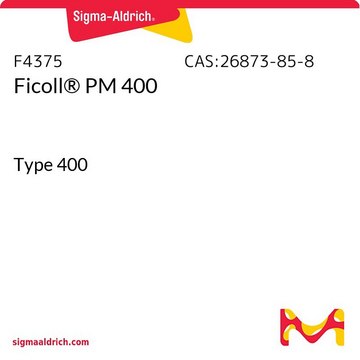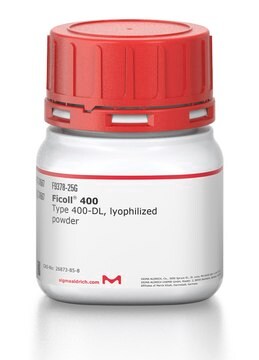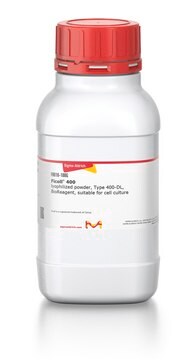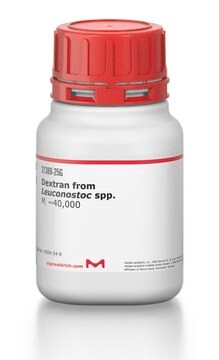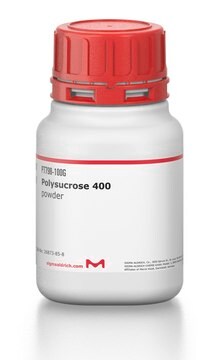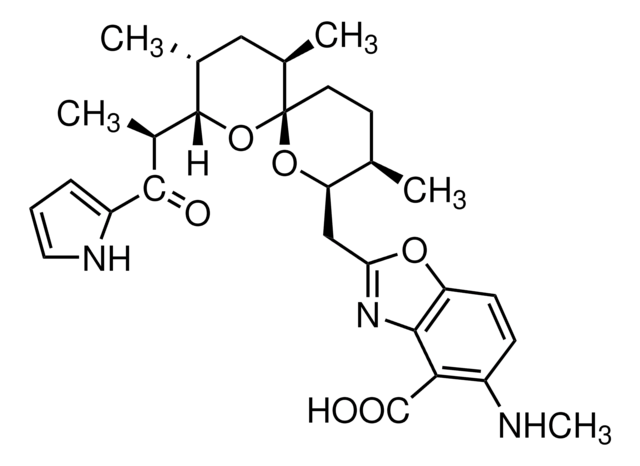F2878
Ficoll® PM 70
Type 70
Synonym(s):
Poly(sucrose-co-epichlorhydrin)
Sign Into View Organizational & Contract Pricing
All Photos(1)
About This Item
Recommended Products
type
Type 70
Quality Level
form
powder
mol wt
~70,000
color
white
solubility
H2O: soluble 100 mg/mL, clear to slightly hazy, colorless to faintly yellow
Looking for similar products? Visit Product Comparison Guide
General description
Ficoll® PM70, a high molecular weight branched polysaccharide polymer, is believed that they do not contain any ionized groups. This sucrose-polymer is formed by the copolymerization of sucrose with epichlorhydrin.
Application
Ficoll® PM 70 has been used:
- as a macromolecule in a comparative study to evaluate its effect in vitrification solutions
- as a supplement in the vitrification solution for the vitrification procedure of oocytes
- as a component of low serum medium for human lung fibroblast cell culture to promote a crowded environment
Biochem/physiol Actions
Ficoll is commonly used as a macromolecular constituent of vitrification solutions. Due to their dense branching, Ficolls also serve as ideal, nearly spherical molecular crowding agents.
FicollTM PM 70 is used as a macromolecular crowding agent in studies of cell volume signaling and protein refolding.It may be used in tissue engineering and macromolecular conformation research for the development, evaluation, and use of macromolecular crowding (MMC) systems and configurations. Ficoll PM-70 can also be used in vitrification research.
Other Notes
A nonionic synthetic polymer of sucrose.
To gain a comprehensive understanding of our extensive range of Polysaccharides for your research, we encourage you to visit our Carbohydrates Category page.
Legal Information
Ficoll is a registered trademark of Cytiva
Storage Class Code
11 - Combustible Solids
WGK
WGK 3
Flash Point(F)
Not applicable
Flash Point(C)
Not applicable
Personal Protective Equipment
dust mask type N95 (US), Eyeshields, Gloves
Certificates of Analysis (COA)
Search for Certificates of Analysis (COA) by entering the products Lot/Batch Number. Lot and Batch Numbers can be found on a product’s label following the words ‘Lot’ or ‘Batch’.
Already Own This Product?
Find documentation for the products that you have recently purchased in the Document Library.
Customers Also Viewed
Emmanuel Dauty et al.
Journal of molecular recognition : JMR, 17(5), 441-447 (2004-09-14)
Aqueous environments in living cells are crowded, with up to >50 wt% small and macromolecule-size solutes. We investigated quantitatively one important consequence of molecular crowding--reduced diffusion of biologically important solutes. Fluorescence correlation spectroscopy (FCS) was used to measure the diffusion
Nobuhiko Tokuriki et al.
Protein science : a publication of the Protein Society, 13(1), 125-133 (2003-12-24)
Unfolded states of ribonuclease A were used to investigate the effects of macromolecular crowding on macromolecular compactness and protein folding. The extent of protein folding and compactness were measured by circular dichroism spectroscopy, fluorescence correlation spectroscopy, and NMR spectroscopy in
M B Burg
Cellular physiology and biochemistry : international journal of experimental cellular physiology, biochemistry, and pharmacology, 10(5-6), 251-256 (2000-12-23)
The non-ideal properties of solutions containing high concentrations of macromolecules can result in enormous increases in the activity of the individual macromolecules. There is considerable evidence that macromolecular crowding and confinement not only occur in cells, but that these are
M Al-Habori
The international journal of biochemistry & cell biology, 33(9), 844-864 (2001-07-20)
Macromolecular crowding has been proposed as a mechanism by means of which a cell can sense relatively small changes in volume or, more accurately, the concentration of intracellular solutes. According to the macromolecular theory, the kinetics and equilibria of enzymes
C M Checura et al.
Theriogenology, 67(5), 919-930 (2006-12-19)
This study was designed to evaluate vitrification procedures for in vitro matured bovine oocytes for efficient blastocyst production after warming, IVF and culture. A second goal was to replace serum as the macromolecular component of the vitrification solution, without compromising
Our team of scientists has experience in all areas of research including Life Science, Material Science, Chemical Synthesis, Chromatography, Analytical and many others.
Contact Technical Service